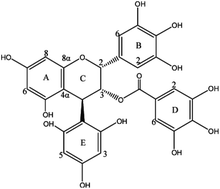The anti-obesity properties of the proanthocyanidin extract from the leaves of Chinese bayberry (Myrica rubra Sieb.et Zucc.)
Abstract
The anti-obesity effects of different proanthocyanidin extracts (PE) from Chinese bayberry (Myrica rubra Sieb.et Zucc.) leaves were evaluated in a high-fat (HF) diet-induced obese rat model. The leaves of Chinese bayberry (LCB), a non-desaccharified proanthocyanidin extract (NDPE), and a desaccharified proanthocyanidin extract (DPE) were compared with orlistat, a conventional anti-obesity drug used as a positive control. The rats from all of the PE-treated groups showed obvious weight loss, with the greatest weight loss in the DPE group (P < 0.05). Compared to the HF group, almost all of the PE-treated groups showed significantly reduced levels of serum TC, TG, AST, ALT, ALP, LDL-C, ADP and a LEP/ADP ratio, and increased levels of HDL-C and LEP. Furthermore, the expression levels of SIRT1, PPAR-γ, C/EBP-α, BMP4 and UCP1 were investigated in the liver, kidney, epididymis and abdominal adipose tissue. Compared to the HF group, PPAR-γ and C/EBP-α levels were significantly reduced and SIRT1, BMP4 and UCP1 levels were significantly upregulated in the DPE-treated group. Our results suggested that PE exerted its anti-obesity effects by upregulating the expression of SIRT1, thus inducing the deacetylation of PPAR-γ and downregulating the expression of C/EBP-α, and also upregulating the expression of BMP4 to boost the levels of brown fat.



 Please wait while we load your content...
Please wait while we load your content...